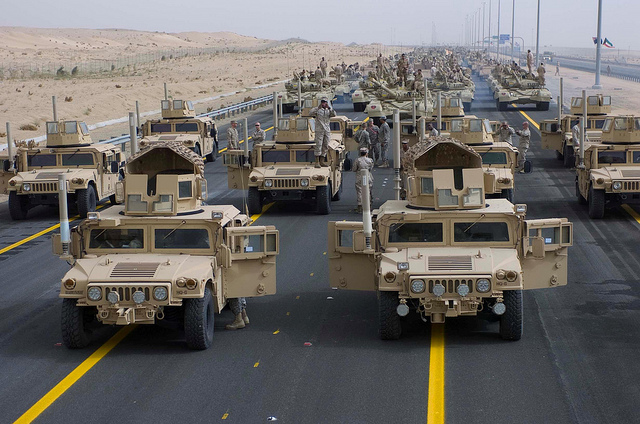February 10, 2016

The Transformers movies were by no means cinematic masterpieces, but give them credit for their unflinching depiction of the oncoming robotic menace. If the evil Decepticons ever come to invade Earth, we should be so lucky to have a robot army work in concert with the U.S. military to defend us. Of course, the Transformers have the distinct disadvantage of not being real…but the robot army part could well be a case of truth being stranger than fiction. According to Automotive News, the U.S. Army will deploy a convoy of self-driving trucks (like the ones pictured above) along Interstate 69 in Michigan this summer. The Army is performing this exercise on American soil in order to determine whether these autonomous military vehicles can perform in a theater of war. If this trial proves successful—and let me be clear that this is pure speculation at this stage—the government could very well deploy this robot army in place of flesh-and-blood soldiers in future wars. In the short term, the convoy will include at least four autonomous army trucks employing dedicated short-range communications (DSRC) technology. The onboard technology utilized by this robot army transmits its speed and location via vehicle-to-vehicle and vehicle-to-infrastructure links between the vehicles and roadside transponders. In turn, these transponders, which have a 300-mile range, transmit data such as lane closures and speed limits that help the robot army to navigate the road. The robot army will also be equipped with radar sensors, cameras and onboard cameras that will help it avoid (or at least limit) the incidence of vehicle crashes. For safety, a human driver leads the robot army to ensure the convoy reaches its destination safely. The robot army program is specifically designed to relieve human soldiers of duties that may be physically taxing or detract from more critical objectives. Paul Rogers, director of the Army’s Tank Automotive Research, Development and Engineering Center, outlines a few of the program’s potential positives. “One vehicle drives and a number of vehicles can follow,” Rogers said. “You won’t need as many drivers. You see commercial truck operators trying similar platooning projects at highway speeds.” The test equipment, including radars, cameras and equipment, currently costs $175,000 per vehicle. However, according to Rogers, a mass-produced version should cost a tenth of that price. If true, the applications of this technology for the private sector would be unlimited (as would the profits). Many in the autonomous vehicle industry favor the roadside transporter model being used by the robot army. This communications technology is already a feature in certain Cadillac and Mercedes-Benz models and could provide a self-driving vehicle alternative going forward. In short, the involvement the U.S. Army in the field of self-driving vehicles is a game changer. While private sector companies like Google are helping to blaze a trail toward a fully autonomous future, even a sliver of the military’s discretionary spending budget would be a boon to the self-driving vehicle industry. Last year, the U.S. Army Tank-Automotive Research, Development and Engineering Center (TARDEC) partnered with Lockheed Martin on developing self-driving military trucks so that human troops wouldn’t fall prey to IEDs on the battlefield. The name they gave to this robot truck program—the Autonomous Mobility Appliqué System (AMAS)—may not be as cool sounding as Optimus Prime, but I guess army people would be the type to focus on precise nomenclature (no matter how prosaic the name may sound to us civilians). See this monument to the military-industrial complex go through its paces in the video below: Image Credit: DVIDSHUB/Flickr
Tags: DSRC , robot army , self-driving vehicles
Hello {{User.FirstName}} {{User.LastName}}.
You are logged in with email {{User.Email}}.